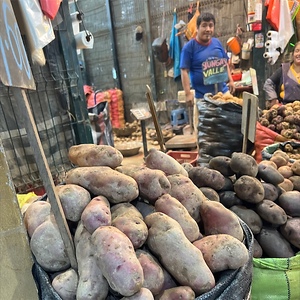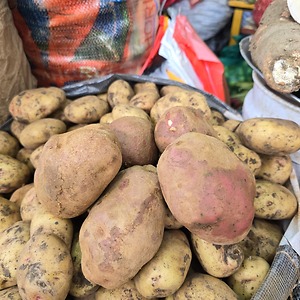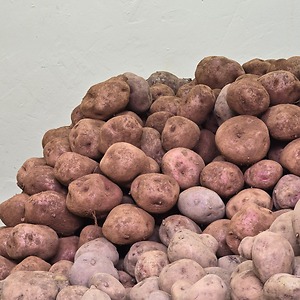


Unica Potatoes
Estimated Inventory, lb : 0
Description/Taste
Unica potatoes vary in size, depending on growing conditions, but are generally considered a medium to large varietal with an elongated, oblong shape. The potatoes are relatively uniform with blunt, curved ends and are often seen in markets still coated in thick layers of soil. Once cleaned, Unica potatoes reveal red skin that ranges in color from red-pink to dark red. Tubers grown in the highlands will appear darker than potatoes cultivated in lowlands or coastal regions. The skin is semi-thin, taut, and smooth with a few textured, rough patches. The surface also showcases shallow, superficial eyes that do not affect the potato’s overall shape. Underneath the skin, the ivory, cream-colored, to pale yellow flesh is dense, slippery, and firm when raw. Cooking the flesh allows it to develop a softer, fluffier, dense, and tender consistency. Unica potatoes have a blend of starchy and waxy qualities but lean more towards floury, starchy characteristics, meaning they contain more dry matter than moisture. Unica potatoes are edible once cooked and have a mild, subtly sweet, and neutral taste.
Seasons/Availability
Unica potatoes are available year-round, with varying peak seasons occurring at different times worldwide. In Kenya, the variety is typically harvested from September to November. In Peru, Unica potatoes are primarily found during the dry season from April to October.
Current Facts
Unica potatoes, botanically classified as Solanum tuberosum, are a Peruvian variety belonging to the Solanaceae or nightshade family. The fast-growing cultivar was developed through the International Potato Center in Lima and was commercially released in the late 20th century. The variety was also released in partnership with the National University San Luis Gonzaga in Ica, earning it the name Unica after the university’s popular abbreviation. Unica potatoes are harvested within 3 to 4 months of planting and are favored by commercial growers for their high yields, producing 10 to 20 tons of tubers per acre when cultivated in ideal conditions. The variety also exhibits disease resistance, drought and heat tolerance, and can thrive in a variety of regions, including lowlands, coastal regions, and highlands. It is important to note that since their commercial release in Peru, Unica potatoes have also been introduced worldwide. The variety has become commercially successful in parts of Central, South, and East Asia and Africa. Unica potatoes are also known as Qingshu 9 in China, Tajikiston in Tajikistan, and Mkanano in Tanzania. The variety is popularly roasted, fried, or boiled and is utilized in a wide array of savory, cooked culinary preparations.
Nutritional Value
Unica potatoes have not been extensively studied for their nutritional properties. Like other commercial potatoes, Unica potatoes may be a source of vitamin C to strengthen the immune system, fiber to regulate the digestive tract, and iron to develop the protein hemoglobin for oxygen transport through the bloodstream. Potatoes also provide some zinc to protect the body against various viruses and bacteria, magnesium to control nerve functions, potassium to balance fluid levels within the body, manganese to form connective tissues, and other nutrients, including calcium, folate, phosphorus, and vitamin K.
Applications
Unica potatoes have a mild, subtly sweet taste suited for cooked preparations. The variety is widely popular for producing crisps and chips as the flesh does not absorb as much oil as other varieties, making it ideal for frying. Unica potatoes are also commonly baked or roasted with other vegetables and fresh herbs as a side dish. In Peru, Unica potatoes are sometimes incorporated as a variation of the classic recipe causa de pollo, a layered dish of mashed potatoes filled with vegetables, poultry, and herbs. The tubers can also be mashed, stuffed with cheese, and later fried to create a mozzarella-stick-like appetizer or utilized in any croquette recipe. Unica potatoes are famous for making French fries and are used in salchipapa, a street food dish of thinly sliced meats cooked with French fries or potato wedges. While less common, Unica potatoes are occasionally utilized in potato cakes, a layered dish of potatoes combined with eggs, cheese, and milk. This layered potato cake is typically served with stuffed rocoto and is from the Arequipa region. Unica potatoes pair well with cheeses such as mozzarella, parmesan, and queso fresco, spices including smoked paprika, cumin, and black pepper, herbs such as oregano, huacatay, and parsley, and meats including beef, pork, and poultry. Whole, unwashed Unica potatoes will keep for several months when stored in a cool, dry, and dark location.
Ethnic/Cultural Info
In Peru, Unica potatoes are often featured as a critical ingredient in papas rellenas, or stuffed potatoes. Recipes for papas rellenas can be traced back to the Pacific War in Peru in the late 19th century. Peru and Bolivia were allied forces against Chile in a battle for possession of the Atacama Desert, a region known for its nitrate deposits. The land was once part of Peru and Bolivia, but after Chile’s victory in the war, the Atacama Desert region was absorbed by Chile. During the war, Peruvian soldiers were required to travel long distances in remote settings to avoid opposing armies. They needed to carry food that could be easily placed in pockets and bags. Papas rellenas became a common food source for soldiers as fried potato-wrapped meats could be easily transported when stored in a cloth. The first-known recipe of papas rellenas stems from the New Manual of Peruvian Cuisine, written in 1895, and since the war, the dish has become a symbolic food of Peru. In the modern day, papas rellenas are made from a combination of yellow and white potato varieties, including Unica, to create a mashed mixture that holds its shape without falling apart. The mixture is also less sticky than using only yellow potatoes, allowing it to be molded. Spices and aromatics flavor the interior minced meat, and the exterior is fried to create a crisp surface.
Geography/History
Unica potatoes are native to Peru and were developed through traditional crossbreeding techniques at the International Potato Center, also known as CIP, in Lima. CIP has created over 2,000 potato varieties with improved resistance to disease and other cultivation characteristics, and Unica potatoes arose from research trials within the Division of Improvement and Utilization of Genetic Resources of CIP. Several breeders worked to develop Unica potatoes, including Jorge Alberto Espinoza, and the crosses for the variety began in 1991 through parent varieties Aphrodite and 387521.3. The initial product of these crosses was labeled CIP No. 392797.22. The first evaluations were conducted at the Experimental Stations in San Ramón and Huancayo in Junín and La Molina in Lima, and the variety was tested for disease resistance. In Huancayo, the new variety was one of the only potatoes that survived an attack of late blight disease. CIP No. 392797.22 was later planted in coastal regions, including Tacne, Barrance, Ica, Majes, Nasca, Virú, and Cañete, and was also studied in the valleys of Nasca and Ica. After seven years of regional trials and evaluations in over twenty regions, CIP No. 392797.22 was given to the National University San Luis Gonzaga in Ica, Peru. The variety was renamed Unica in honor of the University’s common abbreviation and was commercially released in 1998. Unica potatoes received widespread recognition among Peruvian growers for their fast-growing nature and disease resistance, leading the variety to become a commercially produced cultivar. Today, Unica potatoes are still one of the most popular varieties grown in Peru and are planted in the highlands, lowlands, and coastal regions. The variety has also been introduced worldwide. The first international success was through China. Unica potatoes were renamed Qingshu 9 and were planted in over ten different Chinese provinces with extensive cultivation in Ningxia and Qinghai. Unica potatoes were also introduced to Central and South Asia and were planted in Uzbekistan, Tajikistan, Georgia, and Bhutan. In Africa, Unica potatoes have become a favored commercial variety in Kenya. They were introduced in 2016 and are also being evaluated for potential cultivation in Tanzania and Rwanda. The Unica potatoes featured in the photograph above were sourced through local markets in the districts of Miraflores and Surquillo in Lima, Peru.










